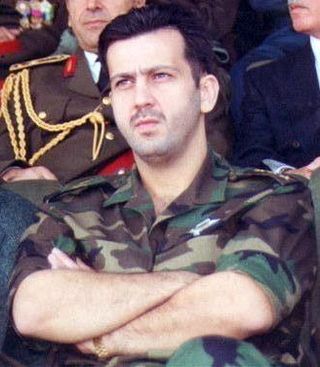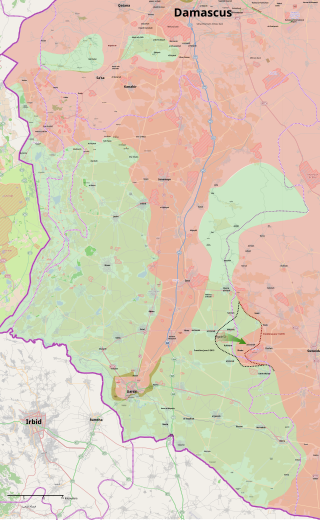August
On 20 August 2023, a large number of protestors in Southern Syria began protesting against the Ba'athist government. Protests erupted first in Karama Square [2] in the Druze-majority city of Suwayda. 42 protests were held across As-Suwayda governorate, [2] and spread to the neighbouring province of Daraa, often known as the "Cradle of the Syrian Revolution", [25] with protests in the Daraa villages Nawa, Jasem Sanamein and Da'el. [46] Protestors in Suwayda waved Druze flags and Syrian revolutionary flags. They also chanted slogans of 2011 Syrian revolution, demanding the downfall of the Assad government and expulsion of Iranian presence from the country. Protestors led mass demonstrations, and sit-ins and blocked roads to the Baath party headquarters in Suweida. [37]
There were reports of government forces shooting on unarmed protestors in the Nawa and Da'el districts of Daraa city on 20 August. [43] [47] There were reports the next day that night-time youth protests near a military security building in Nawa, during which roads were obstructed using burning tires, were followed by confrontations between local fighters and government forces who later shelled the area. [48]
The Syrian Democratic Council expressed its support for the protests on 21 August. [47]
On 22 August, there was a youth protest in the town of Sayda, to the east of Daraa, calling for "the ousting of the regime". [49]
Protests continued on 23 August. [50] Protestors had raided Ba'ath party offices across Southern Syria and blocked the highway connecting Suwayda to Damascus. [37]
The numbers protesting in al-Karama square grew on 24 August, according to opposition media, with slogans including "Syria yearns for liberty, Bashar must step aside," "In the name of Syrian freedom, Iran, recede," "The people of Syria demand liberty," and "May Syria prosper, down with Bashar al-Assad." Banners called for the imposition of UN Resolution 2254. [51] By 25 August, large-scale protests had spread to Idlib, Aleppo, Azaz, Afrin and Al-Bab regions. [52]
By the second week of the protests, commentators had begun describing the country-wide protest waves as a second revolutionary movement. Security forces were deployed to initiate a clampdown on protests in Daraa, Aleppo, Latakia, etc. Due to the presence of armed Druze militias, such as the "Men of Dignity" group and Sheikh al-Karama Forces, the Assad government has been more hesitant to launch crackdowns in Suwayda. However, the Assad government's plans for an upcoming military crackdown were reported by opposition activists. Hundreds of protestors in Suwayda continued to chant anti-government slogans, demanding the overthrow of Bashar al-Assad. [53] [54]
On 28 August, video footage emerged of security forces shooting to suppress protests in Shahba city, Suweida region. The same day, hundreds of demonstrators gathered at the Karama Square; chanting revolutionary slogans and demanding the prosecution of Bashar al-Assad in an international tribunal. The protestors further labelled the dictator as "the criminal of the barrel bombs, sarin gas, and captagon". Protests demanding the ouster of the Assad government also continued in the Idlib and Daraa regions. [55]
By late August, Ba'athist security forces had carried out a wave of arbitrary arrests and detentions across the country, particularly in the coastal regions where the 10th of August movement was amassing supporters. A spokesman of the 10th of August movement stated: "The regime is very good at using violence against people. We are trying to reach a point in Syrian society where we don't give them a chance once we decide to start a revolution". [6]
On 29 August 2023, demonstrations and civil disobedience continued. Al-Karama square in As-Suwayda city saw its tenth consecutive day of protest. Villagers from across western As-Suwayda province gathered in Ariqa, and provincial roads were closed. In eastern As-Suwayda, Ba'ath party offices were closed in Melh. [56] Around 57 protestors were arrested during the crackdown in Daraa. The headquarters of the Ba'ath party in Suweida were occupied and closed down by the protestors. Mass boycotts by residents in the city also led to the shutdown of government institutions. Demonstrations in the main square of Suwayda continued to be engulfed by anti-government slogans, such as: "Step down Bashar, we want to live in dignity". [57] [58] [59]
Protestors in Suwayda raised slogans advocating solidarity with opposition-held regions in Idlib and other parts of North-Western Syria. Kurdish party PYD also supported the protests, advocating the establishment of federalization process in minority provinces. Demonstrators in Daraa raised slogans of "bread, freedom and dignity." On 30 August 2023, reports regarding the Assad government's preparation for a large-scale crackdown to quell the uprisings in Southern Syria began to emerge. [30] By the end of August, the mass-protests resembled the Arab Spring uprisings during the outbreak of the Syrian revolution in March 2011. [5] [60]
On 31 August, clashes broke out in the Damascene country-side between local people and militants of Maher al-Assad's 4th Armoured Division in the town of Zakiyah. This was after a civilian, who discovered that some of the division's commanders bombed a store used for keeping water well machinery, was shot dead by pro-Assad militants. This sparked fierce confrontations between locals and the 4th Armoured Division, killing three militants of the division and two residents. Anti-Assad activities had been rising in Zakiyah since the eruption of protests across Syria, and Assad regime had deployed military troops across Rif Dimashq in August. Several houses of the 4th Armoured Division soldiers were burned down by angered locals. [61] [62]
September
Protests continued on 1 September 2023 across Suwayda and Daraa regions. Small-scale demonstrations also occurred in Tartus and other government-held regions. Thousands of protestors in Suwayda chanted anti-government slogans demanding the resignation of Bashar al-Assad, resulting in the largest anti-regime rallies since the Arab Spring in 2011. Demonstrators in Daraa waved the Syrian revolutionary flags. [63] [64] [8]
Protest activities in southern Syria, especially in Suwayda province, escalated during the first week of September, with demonstrators prolonging their gatherings late into the night and establishing makeshift encampments with prominent banners. Protestors also disfigured a statue of Hafez al-Assad. Many protestors in opposition and SDF-held territories came out publicly in support of Suwayda residents. Protests in Daraa region also continued. [8] [9]
Noting that anti-regime sentiments have become rife in previously loyalist areas of Ba'ath party, director of Suweyda24 news-outlet Nour Radwan stated: “In the areas where the regime has full-control, people are always watching us. People are really waiting to protest, but they are still scared of the security forces". [9]
April 2024
On 17 April, "Independence Day" saw a pivotal protest in As-Suwayda, Syria. Demonstrators barred regime and Baath Party officials from accessing national monuments of "The Great Syrian Revolution" all over As-Suwayda, [76] and blocked the display of regime symbols and Bashar al-Assad's images. [77] This act of defiance marked a significant shift, the first of its kind since the protests began in 2011.
On April 25, in response to the detention of university student "Hani Obaid" in Latakia for supporting the Suwayda protests, demonstrators detained several military personnel including a regiment commander, a staff brigadier, a colonel, and the head of the Immigration and Passports Branch. [78] The regime dispatched military reinforcements to rescue the detained officers, but were surrounded, compelling the regime to release the student on April 28. [79]










